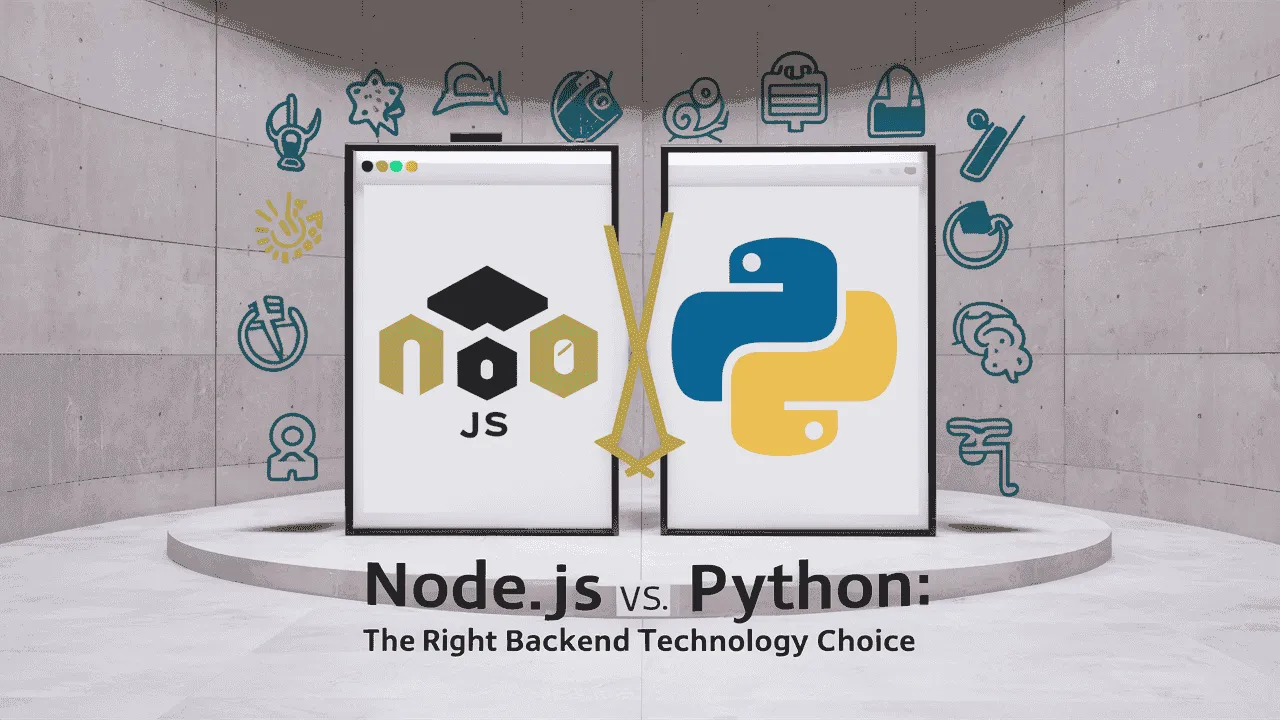Picking the right backend technology is more important than ever. If you’re building a new website, app, or software project, you’re probably wondering: Node.js vs Python — which one should you choose? Both are popular and powerful, but they’re built for different types of projects.
Node.js is based on JavaScript and runs on the fast V8 engine from Google. It’s great for apps that need to handle many users at once — like chat apps, real-time tools, or microservices. Thanks to its non-blocking system, Node.js doesn’t slow down when handling lots of data at the same time.
Python, on the other hand, is known for being simple and easy to read. It’s a top choice for data science, AI, and web development. Python has amazing tools like Django and Flask that help developers build websites quickly and with less code.
So when it comes to choosing the right backend technology: Node.js or Python, how do you decide? In this guide by Owrbit, we’ll break down the strengths and weaknesses of both.
We’ll look at different use cases, performance, and community support to help you understand what fits your project better. Whether you’re starting something new or growing your current business, knowing the difference between Node.js vs Python is key.
Some projects are better suited for Node.js, especially if speed and real-time performance matter. Others work best with Python, especially if you’re working with data or want clean, readable code.
Let’s take a closer look at Node.js vs Python and figure out the right backend technology: Node.js or Python for your project in 2025.
By the end of this guide, you’ll be able to clearly see the pros and cons of both. You’ll learn where Node.js vs Python really shines and how to pick the right backend technology: Node.js or Python that matches your goals.
So, ready to dive in? Let’s explore the world of Node.js vs Python and help you choose the right backend technology: Node.js or Python for your next big idea.
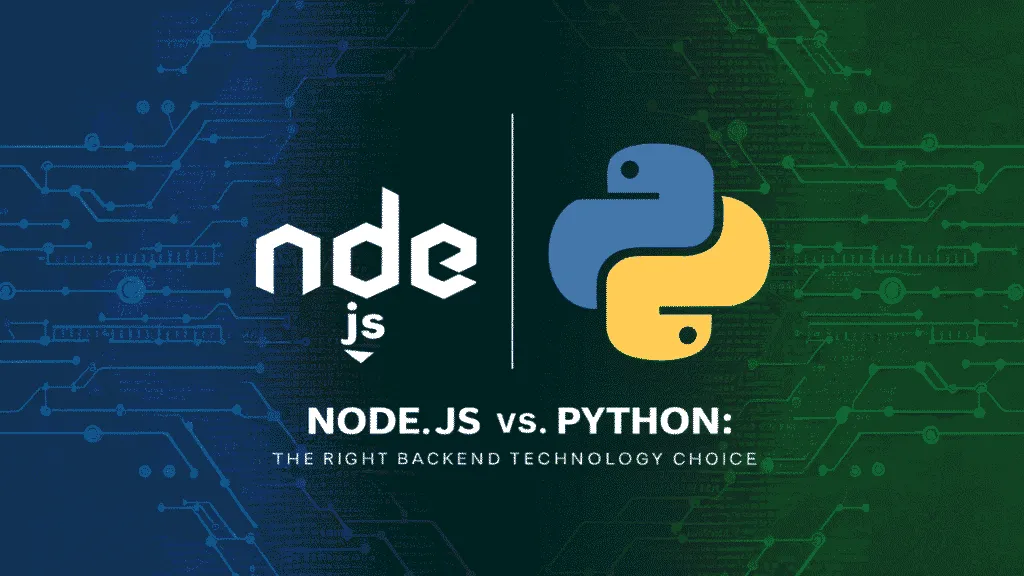
Introduction to Backend Technologies :
Backend technologies are the backbone of any web or mobile application. While the front end is what users see and interact with, the backend is what powers the logic, stores the data, and handles everything behind the scenes. It connects the user interface to the database, handles API requests, manages authentication, and performs countless other tasks to keep apps running smoothly.
Choosing the right backend technology can have a huge impact on the performance, scalability, and maintainability of your application. It affects how fast your app runs, how easily it can grow with more users, and how simple it is for developers to build and manage features.

There are many backend technologies available, but two of the most talked-about in 2025 are Node.js or Python. Each has its own strengths, tools, and ideal use cases. If you’re trying to decide between Node.js vs Python, it’s important to understand how backend technologies work and what your project really needs.
In the sections ahead, we’ll explore the differences between Node.js vs Python and help you choose the right backend technology: Node.js or Python, based on your goals and the type of app you’re building.
Overview of Node.js :
Node.js is a runtime environment that lets you run JavaScript code outside of a web browser — usually on a server. It was built using Google’s V8 JavaScript engine (the same one used in Chrome) and is designed to build fast, scalable, and efficient applications.
Before Node.js, JavaScript was mainly used for frontend development (in the browser). But with Node.js, developers can now use JavaScript for backend development too — meaning you can use one language for the full stack of your application.
Node.js is especially popular for real-time applications, APIs, microservices, and projects that require handling many users at the same time — like chat apps or live dashboards. It works using a non-blocking, event-driven system, which helps it stay fast even under heavy workloads.
In short, Node.js allows developers to build powerful server-side applications using JavaScript.

Key Features of Node.js :
Node.js offers a range of powerful features that make it a top choice for modern backend development. Let’s explore some of its key strengths:
- Asynchronous and Non-blocking I/O
- Node.js uses an event-driven model, which means it doesn’t wait for tasks like reading files or querying databases to finish before moving on. This allows it to handle many requests at the same time without slowing down.
- Fast Performance
- Node.js is built on Google’s V8 engine, which makes JavaScript run super fast. It compiles code directly into machine code, allowing for quick execution and better performance.
- Single Programming Language
- With Node.js, developers can use JavaScript for both frontend and backend. This makes development faster and easier since you don’t need to learn or manage two different languages.
- Scalable Architecture
- Node.js is ideal for building scalable applications. Its lightweight, non-blocking nature makes it a good fit for handling thousands of simultaneous connections — great for APIs and real-time apps.
- Large and Active Community
- Node.js has a massive global community. You can find lots of open-source packages, libraries, and tools on npm (Node Package Manager), making development faster and more efficient.
- Real-Time Data Handling
- Node.js is perfect for apps that need to update in real time, like chat apps, online games, and live collaboration tools.
- Cross-Platform Development
- Using frameworks like Electron, developers can build desktop applications for Windows, macOS, and Linux — all using Node.js or Python.
- Microservices-Friendly
- Node.js supports building applications in small, manageable services (microservices), making it easy to update, scale, and maintain large apps over time.
These features make Node.js a reliable, fast, and scalable solution for building everything from small APIs to large, real-time web applications.
Overview of Python :
Python is a popular, easy-to-learn programming language known for its clean and readable code. It was created with simplicity in mind, which makes it a great choice for both beginners and experienced developers. Python is a general-purpose language, meaning you can use it to build websites, automate tasks, analyze data, create machine learning models, and much more.
Python is often used for backend web development, thanks to powerful frameworks like Django and Flask. It’s also the go-to language for fields like data science, artificial intelligence, and automation.
One of the biggest strengths of Python is its huge collection of libraries and its strong, supportive community. This allows developers to build projects faster and solve problems more easily.
In short, Python is a flexible and powerful language that helps you build almost anything — with less code and less hassle.

Key Features of Python :
Python is loved for its simplicity, flexibility, and powerful tools. Let’s look at some of the main features that make Python one of the top choices for backend development:
- Simple and Readable Syntax
- Python’s code is easy to read and understand, making it beginner-friendly and great for teams who want clean, maintainable code.
- Powerful Web Frameworks
- Python has strong frameworks like Django and Flask that help you build secure and scalable web applications quickly.
- Huge Collection of Libraries
- Python offers thousands of libraries for tasks like data processing, machine learning, database management, and more — saving developers time and effort.
- Cross-Platform Compatibility
- Python works on Windows, macOS, and Linux without needing major changes, making it ideal for cross-platform development.
- Great for Data Science and AI
- Python leads the way in data-related fields, with libraries like Pandas, NumPy, TensorFlow, and Scikit-learn making complex tasks easier.
- Strong Community Support
- With a large and active developer community, Python users benefit from extensive documentation, tutorials, and open-source tools.
- Supports Multiple Programming Styles
- Python lets you use both object-oriented and procedural programming approaches, giving you more flexibility in how you build your app.
- Fast Development Speed
- Python allows you to build and launch projects quickly, making it a popular choice for startups and MVPs (minimum viable products).
These features make Python a reliable and efficient option for backend development, especially when you need clean code, fast results, and strong support for data-driven tasks.
Node.js vs Python: Ultimate Comparison
When choosing the right backend technology: Node.js or Python, it’s important to compare them in different areas — from performance and security to cost and community. Let’s break it down:
Checkout Find the Ideal Dedicated Server Specs for Speed, Security & Growth
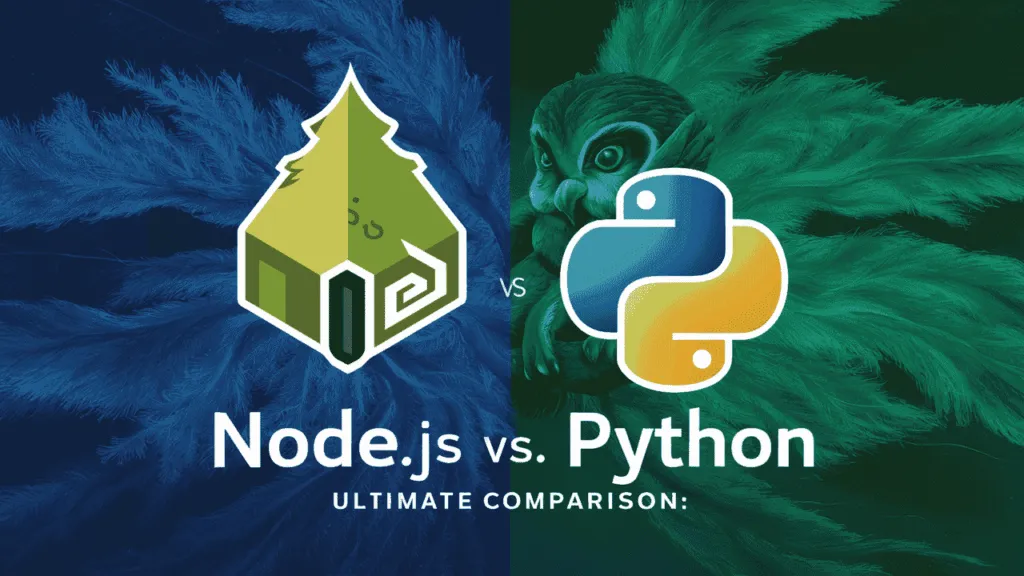
Performance Comparison :
When it comes to performance, both Node.js or Python have their strengths — but they’re designed for different kinds of tasks. Let’s compare them based on speed and scalability.

Speed and Efficiency :
When you’re choosing the right backend technology: Node.js or Python, one of the most important things to consider is how fast and efficient it is — especially if your app needs to handle a lot of users or requests.
Node.js :
Node.js is built for speed. It runs on the V8 JavaScript engine, which compiles JavaScript directly into machine code for faster execution. One of the biggest advantages of Node.js is its non-blocking, asynchronous nature. This means it doesn’t wait for one task to finish before starting another. Instead, it handles many tasks at the same time — making it perfect for real-time apps like chat platforms, live streaming, and online games.
Python :
Python is not as fast as Node.js when handling large numbers of users or real-time traffic. It runs code synchronously by default, meaning it handles one task at a time. Although there are ways to make Python asynchronous (like using asyncio), it still doesn’t match the raw speed of Node.js in real-time environments. However, Python performs very well in tasks that need a lot of CPU power — like data analysis, scientific computing, and artificial intelligence.
If your main focus is building a fast, real-time, and responsive application, Node.js offers better speed and efficiency. Python, while not as fast in user-heavy apps, is still powerful in data-driven environments where processing power matters more than speed.
Security Considerations :
Security is a critical part of any backend technology. Whether you’re building a small app or an enterprise-level platform, it’s important to know how well your chosen backend handles common threats and vulnerabilities. Let’s explore how security compares in Node.js vs Python.
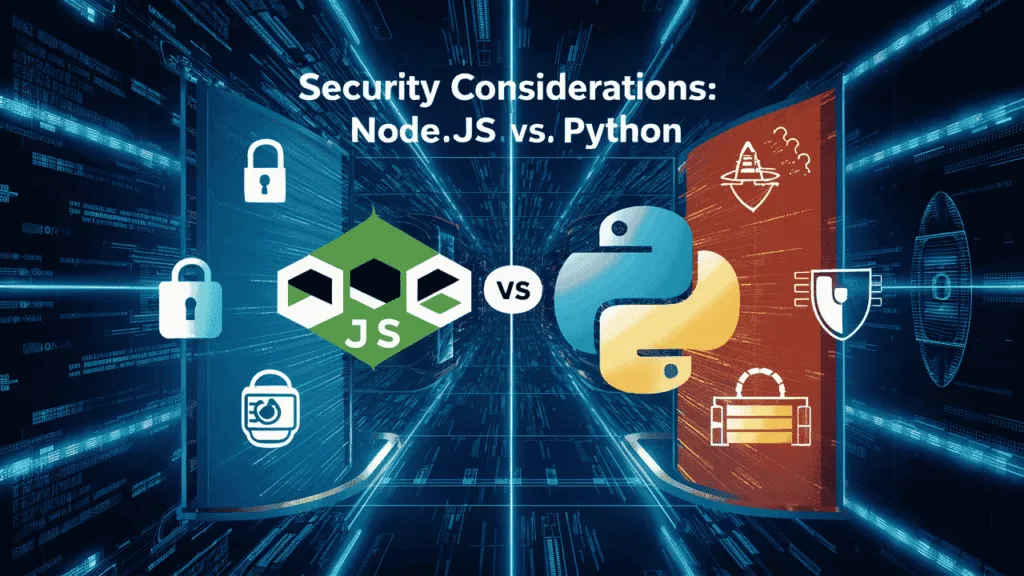
Securing Node.js Applications :
Node.js is a powerful backend technology, but securing a Node.js application requires attention to detail. Since Node.js uses a large ecosystem of packages through npm, one of the main risks comes from third-party modules. A small security flaw in a dependency can create big problems if not handled properly.
Here are some key practices to secure Node.js applications:
- Keep Dependencies Updated
- Regularly update all npm packages. Use tools like
npm auditorSnykto find and fix known vulnerabilities.
- Regularly update all npm packages. Use tools like
- Use Security Middleware
- Use middleware like
helmetto set secure HTTP headers and prevent common attacks such as XSS, clickjacking, and others.
- Use middleware like
- Validate and Sanitize User Input
- Always check and clean user input to avoid injection attacks, including SQL injection, command injection, or NoSQL injection.
- Limit Request Payload Size
- Set limits on the size of incoming data to prevent denial-of-service (DoS) attacks.
- Manage Secrets Securely
- Use environment variables to store API keys, tokens, and passwords. Never hardcode them into your codebase.
- Use HTTPS
- Always serve your application over HTTPS to encrypt data in transit and protect users from man-in-the-middle (MITM) attacks.
- Control Access and Permissions
- Implement role-based access controls and avoid giving more permissions than necessary.
- Error Handling
- Avoid exposing internal errors or stack traces to the user. Use generic error messages and log details securely.
Securing a Node.js application means being proactive — choosing trusted packages, writing safe code, and regularly checking for vulnerabilities. While Node.js is fast and flexible, developers must follow best practices to build secure applications.
Securing Python Applications :
Python is widely used in backend development, especially for web frameworks like Django and Flask. While Python itself is considered a safe language, securing Python applications depends heavily on how the code is written and how the app is configured.
Below are key practices to keep Python applications secure:
- Use Trusted Frameworks
- Frameworks like Django and Flask come with built-in security features. For example, Django automatically escapes output to prevent XSS attacks and includes CSRF protection by default.
- Input Validation and Sanitization
- Always validate and sanitize user inputs to avoid SQL injection, XSS, and other injection attacks. Use libraries like
Bleachfor sanitizing HTML content.
- Always validate and sanitize user inputs to avoid SQL injection, XSS, and other injection attacks. Use libraries like
- Keep Packages Updated
- Use tools like
pip-audit,safety, orbanditto check for known vulnerabilities in Python packages.
- Use tools like
- Use Environment Variables for Secrets
- Never store API keys, tokens, or database passwords directly in your code. Use
.envfiles or secure vaults like AWS Secrets Manager or HashiCorp Vault.
- Never store API keys, tokens, or database passwords directly in your code. Use
- Enable HTTPS
- Serve your app over HTTPS to encrypt communication between the client and server. This helps protect sensitive data and user credentials.
- Limit Error Information
- Don’t show detailed error messages to end users. They may reveal internal logic or stack traces that hackers can exploit.
- Use Access Control and Authentication Libraries
- Use robust authentication systems like
Django Allauth,Flask-Login, or OAuth libraries. Always hash passwords using strong algorithms likebcrypt.
- Use robust authentication systems like
- Set Proper Permissions
- Make sure that file permissions are restrictive, especially for configuration files or scripts that hold sensitive data.
Securing Python applications involves smart configuration, regular audits, and safe coding practices. With powerful frameworks and a strong ecosystem, Python makes it easy to build secure apps—if developers stay mindful of common threats and use the right tools.
Cost of Development :
When choosing between Node.js or Python for a backend project, understanding the development and maintenance costs is crucial. These costs are influenced by factors like development time, available talent, and long-term upkeep.
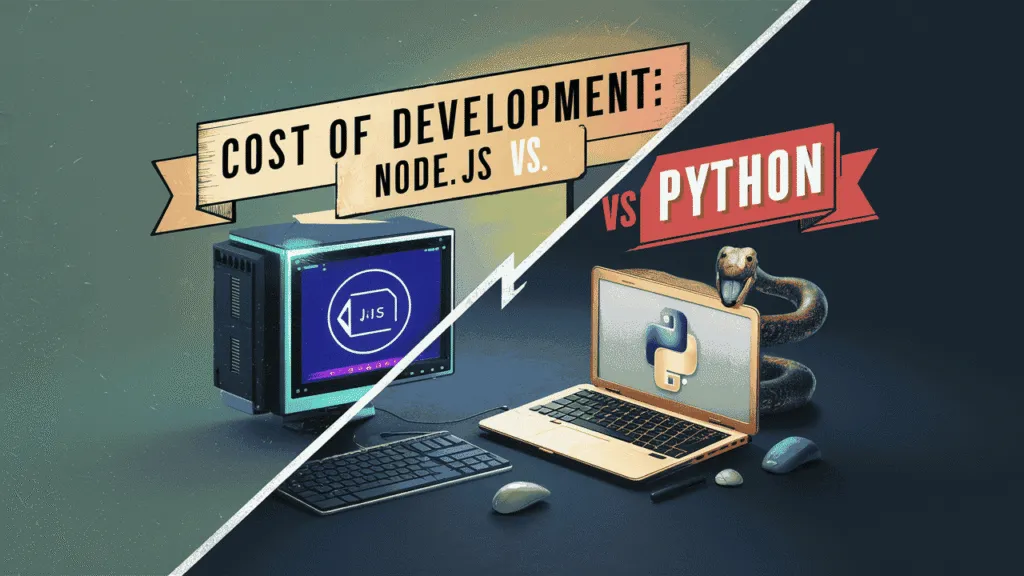
Development Time and Resources :
Choosing the right backend technology significantly impacts how fast your application gets built and how much it will cost in terms of developer resources.
Node.js :
- Faster Development with Full Stack JavaScript: Since Node.js uses JavaScript, developers can work on both the frontend and backend using the same language. This unification can reduce the development time and team size, making the process more efficient.
- Rich Package Ecosystem: Node.js has access to over 1 million packages via npm, allowing developers to integrate functionalities without building everything from scratch.
- Event-Driven Architecture: Ideal for building fast and responsive real-time applications like chats, live notifications, or collaboration tools.
Python :
- Readable and Simple Syntax: Python is designed to be easy to read and write, which helps teams develop features more quickly and with fewer bugs.
- Great for MVPs and Prototypes: Python is often chosen for startups and early-stage projects because it enables rapid prototyping.
- Framework Support: Frameworks like Django and Flask come with built-in features (like admin panels and ORM) that accelerate development for traditional web apps.
Long-term Maintenance Costs :
When selecting the right backend technology—Node.js or Python—thinking beyond the initial build is essential. Long-term maintenance can impact your budget, team workload, and overall project stability.
Node.js :
- Faster Updates, More Frequent Changes: Node.js evolves quickly, with frequent updates and changes in packages. While this keeps tech fresh, it may increase the time spent on updates, debugging, or compatibility fixes.
- Async Complexity: The asynchronous, non-blocking nature of Node.js is powerful but can lead to code that’s harder to read and maintain in larger projects if not managed properly.
- Community Tools Help: Strong tools like PM2 and frameworks like NestJS improve project structure and reduce technical debt over time.
Python :
- Stable Language: Python is known for its backward compatibility and stability. This lowers the chance of breaking changes when upgrading your project or libraries.
- Less Frequent Updates: Libraries and frameworks like Django and Flask are stable, mature, and thoroughly documented, reducing the need for frequent patches.
- Ease of Maintenance: Thanks to its clean syntax and coding principles, maintaining Python code is generally easier, especially for teams with new developers.
Job Market Trends for Node.js or Python
When deciding between backend technologies, understanding the current job market for Node.js developers and Python developers is crucial. This helps aspiring developers, tech recruiters, and startups make better hiring and learning decisions.

1. Demand for Developers :
When comparing Node.js or Python, one of the key deciding factors for developers and companies alike is the demand for backend developers in the job market.
Node.js Developer Demand :
- Node.js has gained massive popularity in recent years, especially among startups, SaaS companies, and agile development teams.
- The rise of full-stack JavaScript (e.g., MERN stack) has led to high demand for Node.js developers who can handle both backend and frontend responsibilities.
- Companies building real-time applications like chat apps, streaming services, and collaborative tools often prefer Node.js due to its non-blocking I/O model and high scalability.
- There’s a steady increase in job postings for roles like Node.js backend developer, JavaScript engineer, and API developer in India, the US, and European markets.
Python Developer Demand :
- Python continues to be one of the most in-demand programming languages globally, not just for backend development, but also for data science, machine learning, AI, automation, and web development.
- Many enterprises and educational institutions choose Python for its simplicity, readability, and versatility.
- Python is widely used in domains such as fintech, edtech, healthcare, and research, where data handling and analytics play a central role.
- Job titles like Python backend developer, Django/Flask developer, Data Engineer, and Machine Learning Engineer consistently appear among the top tech openings worldwide.
If you’re targeting fast-paced web development roles or startup jobs, Node.js developer positions are in high demand. If you’re aiming for opportunities in AI, data science, or enterprise application development, the Python job market offers even broader career paths.
2. Salary Expectations
When evaluating the best backend stack for your career or team, salary is a crucial factor. Let’s break down how Node.js vs Python salaries compare across roles and regions.
Node.js Developer Salaries :
- In the context of Node.js vs Python, Node.js developers typically earn competitive salaries, especially in startups and fast-growing tech companies.
- Entry-level Node.js backend developers in India can expect to earn between ₹4 LPA to ₹7 LPA, while experienced developers with full-stack JavaScript skills often earn ₹10–18 LPA or more.
- In the US and Europe, Node.js developers command annual salaries ranging from $80,000 to $130,000 depending on experience, project complexity, and cloud expertise.
- Companies building real-time apps or using the MERN stack are willing to pay a premium for Node.js developers with performance optimization skills.
Python Developer Salaries :
- Python’s widespread use across industries like AI, machine learning, data science, and web development makes it one of the highest-paying languages.
- In India, Python developers typically earn ₹5 LPA to ₹9 LPA at entry level, with mid to senior roles ranging from ₹12 LPA to ₹25+ LPA, especially in MNCs or AI-focused startups.
- In international markets like the US, Python developers average $90,000 to $150,000 annually, with Django and Flask specialists in high demand.
- Python’s role in data-heavy applications further increases its salary range, especially for roles like backend developer, data engineer, and automation engineer.
From a Node.js vs Python salary standpoint, both technologies offer lucrative career paths. However, Python has a slight edge in data-centric roles, while Node.js pays well in real-time web development.
Ultimately, choosing the right backend technology: Node.js or Python depends on your career focus—whether it’s data and AI (Python) or web applications and microservices (Node.js).
🚀 Power Your Code with Owrbit’s Node.js or Python Hosting
Whether you’re building with Node.js or Python, your backend deserves hosting that’s fast, secure, and optimized for performance. At Owrbit, we deliver cutting-edge hosting environments designed specifically for developers, startups, and growing businesses.

Why Choose Owrbit for Node.js or Python Hosting?
- ✅ Blazing-Fast Performance – NVMe SSDs, high-speed bandwidth, and powerful CPUs ensure your applications run faster than ever.
- ✅ Developer-Ready Environments – Full support for Node.js, Python, databases, and version control systems right out of the box.
- ✅ Scalable Infrastructure – Easily upgrade as your traffic grows—perfect for startups and enterprise-grade apps alike.
- ✅ Full Root Access & Control – Total freedom to deploy, configure, and scale your backend exactly how you need it.
- ✅ 24/7 Expert Support – Our tech team is always here to help you troubleshoot, optimize, and grow.
- ✅ Affordable Plans – Powerful hosting without the hefty price tag. No hidden fees—just pure performance.
🌐 Get Started with Owrbit in 6 Easy Steps
Launching your Node.js or Python project has never been easier. Follow these 6 simple steps to get online with Owrbit:

- Choose a Hosting Plan Built for Developers
- Select from our optimized Node.js or Python hosting plans, designed to suit personal projects, startups, and enterprise needs.
- Pick Your Ideal Server Location
- Deploy closer to your audience with high-speed servers in India and premium offshore regions like Luxembourg or the Netherlands.
- Domain Setup Made Easy
- Connect an existing domain or register a new one right from the Owrbit dashboard.
- Start Instantly with Node.js & Python Pre-Installed
- Save time with pre-configured environments—no extra setup required. Just upload your app and you’re ready to go.
- Deploy via Git or File Manager
- Upload files or use Git integration for seamless deployment, version control, and updates.
- Go Live & Scale Without Limits
- Enjoy 99.99% uptime, dedicated resources, and expert support as your app grows.
Fast setup, full control, and unbeatable support—Owrbit is the right choice for serious developers.
Conclusion: Making the Right Choice
Choosing between Node.js vs Python really depends on the specific needs of your project. If your focus is on building fast, real-time applications like chat apps, online gaming platforms, or scalable APIs, then Node.js may be the better option. It shines in handling multiple simultaneous connections and offers a highly efficient development environment thanks to its non-blocking I/O model.
On the other hand, if your project leans more towards machine learning, data analysis, or requires rapid development with clear syntax, then Python is a strong candidate. Its mature libraries, simple syntax, and huge ecosystem make it ideal for both beginners and experienced developers.
When evaluating the right backend technology: Node.js or Python, think about the long-term goals of your application, your team’s experience, performance expectations, and maintenance requirements. The Node.js vs Python debate doesn’t have a one-size-fits-all answer, but by understanding their strengths and weaknesses, you can confidently choose the right backend technology: Node.js or Python for your success in 2025 and beyond.
Ultimately, the best choice in the Node.js vs Python comparison comes down to aligning your tech stack with your business needs. Whether you’re building a startup MVP or a full-scale enterprise system, selecting the right backend technology: Node.js or Python will play a major role in your project’s performance, scalability, and future growth.
Discover more from Owrbit
Subscribe to get the latest posts sent to your email.



